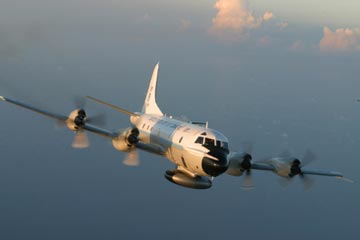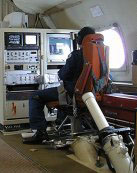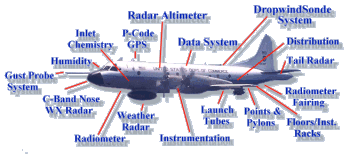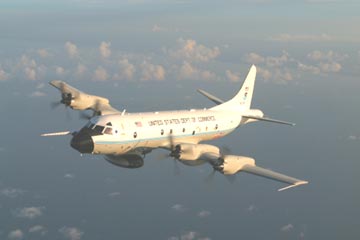| Lockheed
WP-3D Orion
Click for Aircraft Backgrounder

Two
of the world's premier research aircraft, the renowned
NOAA WP-3D Orions, participate in a wide variety
of national and international meteorological, oceanographic
and environmental research programs
in addition to their widely known use in hurricane research
and reconnaissance. These versatile turboprop aircraft
are equipped with an unprecedented variety of scientific
instrumentation, radars and recording systems for both
in-situ and remote sensing measurements of the atmosphere,
the earth and its environment. Obtained as new aircraft
from the Lockheed production line in the mid-70's, these
robust and well maintained aircraft have led NOAA's
continuing effort to monitor and study hurricanes and
other severe storms, the quality of the atmosphere,
the state of the ocean and its fish population, and
climate trends.
| With
their world-wide operating capability, they have
participated in numerous research experiments from
the Indian Ocean, Australia and the Solomon Islands
to Ireland, the North Sea and the Alps. On a national
scope they have operated from the Arctic Ocean and
Alaska through most regions of the U.S. and into
the Caribbean. Hurricane and tropical storm research
have taken place in the Atlantic, Caribbean, Gulf
of Mexico and the Eastern Pacific. Estimated useful
lifetime for these two research platforms is another
10 to 15 years. |
 |
STANDARD
AIRCRAFT SPECIFICATIONS
| Type
Engines: |
4
Allison T56-14 Turbo Prop Engines
Each rated at 4600 Shaft Horse Power (SHP) |
| Crew:
|
2
Pilots, Flight Engineer, Navigator, Flight Director
(meteorologist), 2 or 3 Engineering/Electronic specialists,
Radio/Avionics specialist, and a up to 12 Scientist
or Media personnel. |
| Max.
Takeoff Weight: |
135,000
lbs. |
| Ceiling: |
27,000'
|
| Rate
of Climb: |
Up
to 3000 FPM depending on aircraft gross weight and
density altitude |
| Operational
Airspeeds: |
170
- 250 KIAS |
| Electrical:
|
4
Generators (3 are engine driven, 1 Auxiliary Power
Unit)
each generator yields 120 volt, 3 phase, 400HZ power
90 KVA max power |
| Max.
Gross Weight: |
135,000
lbs max takeoff weight
114,000 lbs max landing (103,880 is normal) |
| Empty
Weight: |
Approximately
73,000 lbs depending on scientific gear installed |
| Maximum
zero Fuel weight: |
Approximately
77,000 lbs. |
| Useful
Load: |
Approximately
62,000 lbs |
| Fuel
Load: |
58,000
lbs. |
| Type
Fuel: |
JP4,
JP5, JP8, JET A, JET A-1, JET B |
| Standard
Fuel Burn: |
4500
- 6000 lbs/hr depending on altitude and airspeed
|
| Maximum
Range and Duration: |
LOW
ALTITUDE - 2500 NM OR 9.5 HRS
HIGH ALTITUDE - 3800 NM OR 11.5 HRS |
| Dimensions
(external): |
Wingspan
= 99 ' 8"
Length = 116' 10"
Height to top of fin = 34' 3"
Top of fin to lower skin = 24' 4" |
| Additional
Standard Equipment (Cockpit): |
Skywatch
Collision Avoidance System (TCAS)
Altitude Alert System |

| Skywatch
Collision Avoidance System (TCAS): |
An airborne traffic advisory system that assists
the flight crew in visual acquisition of aircraft
that may pose a collision threat. |
| Altitude
Alert System: |
System that provides flight crew with visual
and audio warnings about a variety of flight conditions
regarding the altitude of the aircraft. |
| Radars: |
Rockwell
Collins C-band nose radar
Lower fuselage C-band research radar – 360 deg. horizontal fan beam |
| Cloud
Physics: |
PMS
2-dimensional and 1-dimensional precipitation and
cloud particle probes
PMS Forward and Axially scattering particle probes
Aerosol sampling system |
| Radiation: |
Sea
surface temperature radiometer
CO2 air temperature radiometer
Eppley solar and terrestrial pyranometer and pyrgeometer
radiometers |
| Expendables: |
GPS
dropwindsonde atmospheric profiling system
Airborne Expendable Bathythermographs (AXBT’s)
|
| Miscellaneous: |
C-band
and Ku-band scatterometers
Stepped Frequency Microwave Radiometer
Radome Flow Angle Sensors
External Wing Store Station Mounts
Dual Inertial and GPS Navigation Systems |

View
more WP-3D information
Nose
art from the WP-3Ds, N42RF and N43RF
Copyright © The Jim Henson Company
The
WP-3D Orion aircraft are on standby or deployed for
hurricane research and reconnaissance 120 days each
year. Each aircraft averages between 90 and 120 days
deployed around the globe for other research projects,
while flying 300 to 400 hours every year. Remaining
days are devoted to system integration and calibration,
aircraft maintenance, and pilot proficiency training.
The
NOAA P-3’s will be contributing to two large-scale
research efforts in the coming year. The Bow Echo
and Mesoscale Convective Vortices Experiment (BAMEX)
and the South American Low Level Jet Experiment (SALLJEX)
are extensive weather related projects which require
the NOAA P-3s participation to collect airborne data.
BAMEX
The
P-3 aircraft will participate in The Bow Echo and
Mesoscale Convective Vortices (MCV’s) Experiment
(BAMEX) late May to early July 2003. This experiment,
led by NOAA’s National Severe Storms Laboratory,
is a major field project to study the evolution of
Bow Echoes and Mesoscale Convective vortices. These
weather systems can have a profound effect on local
weather by producing widespread heavy rainfall, and
potentially flash flooding. Most of the knowledge
on these systems comes from numerical simulations.
Little is known about how the horizontal circulations
form, how predictable such circumstances might be,
and what determines their length scales.

Aircraft are required to gather nearly all of the
scientific data due to the short lifecycles and small
sizes (~50-500 km diameter) of bow-echo mesoscale
convective systems (MCSs). The NOAA P-3 will work
with a Navy P-3 carrying ELDORA, a sophisticated doppler
radar, to fly the leading line convection of the bow-echo
system in order to map the complete circulation near
this line and rearward of the stratiform region. The
NOAA P-3 will fly a staggered pattern to map the air
motions up to 80 km to the rear of the line. The NOAA
P-3, along with the Naval Research Laboratory P-3
aircraft, will provide 3-dimensional air motion and
reflectivity observations over the domain of the precipitation
region of the system, emphasizing the system-scale
structure and evolution.
For
additional information on BAMEX visit http://www.box.mmm.ucar.edu/bamex/science_framset.html
and http://www.crh.noaa.gov/lsx/science/bamex.htm
SALLJEX
The
South American low-level jet program is an internationally
coordinated effort to contribute to the understanding
of the role of this system in moisture and energy
exchange between the tropics and subtropics. The exchange
between these regions affects regional hydrology,
climate and climate variability. Ultimately, scientists
will use the data collected in this experiment to
improve short and long term predictions. The field
observation campaign (SALLJEX) portion of the program
will take place November 2002- March 2003.
The NOAA P-3 aircraft is an essential part of the
field program to collect high spatial resolution measurements.
The main objective of the P-3 flights will be to provide
a detailed representation of the structure and variability
of the low-level jet east of the Andes. The P-3 will
collect secondary data to assess the relationship
between mesoscale convective complexes over northern
Argentina or western Paraguay and the low-level jet,
the structure of cold frontal surges near the eastern
slopes of the Andes, and the mesoscale variability
over the Altiplano. The P-3 will collect this data
January-February 2003.
For additional information on SALLJEX visit http://www.joss.ucar.edu/salljex
|